![[Druze people (Israel)]](../images/i/il-druz5s.gif)
![[Druze people (Israel)]](../images/i/il-druz.gif) images by Dov Gutterman and David
Kendall
images by Dov Gutterman and David
Kendall
Last modified: 2025-09-06 by martin karner
Keywords: druze | jebel druze | israel | sultan pasha | unidentified flag | magen david | star: 6 points (outlined) | star (faceted) |
Links: FOTW homepage |
search |
disclaimer and copyright |
write us |
mirrors
![[Druze people (Israel)]](../images/i/il-druz5s.gif)
![[Druze people (Israel)]](../images/i/il-druz.gif) images by Dov Gutterman and David
Kendall
images by Dov Gutterman and David
Kendall
See also:
The Druze people are 400'000 living in Syria (mainly in the area of Jabal ad-Duruz – Druze
Mountains), Lebanon and Israel and the shape of the flag is common to all of them. You may notice the
former independent state of the Druze in Jabal ad-Duruz under the
French in the 1920's. The flag has no fixed proportions and the items I examined varies from 2:3 to 8:11.
Usually the 8:11 is used in Israel (possibly to ease production by using the same proportions as the
Israeli flag).
Dov Gutterman, 1 October 1998
[Both types of Druze flags: with green triangle and without (source)]
During my visit of 2 October 2001 to Mas'ade,
the only flags I spotted were Druze flags in 1:1 ratio. When I
visited Peqi'in (Buqei'a) in the
Galilee, I saw the same flag.
Dov Gutterman, 21 October 2001
[Square flag (source)]
Zvi Ruder sent me some information from a report by Günter Mattern of Switzerland and Jarig Bakker translated it:
Lebanon – Druzes
Sheikh Bahshatti Gheith took his seat of honor in the Majlis, the parliamentary room, flanked by two 5-pointed stars, of which each point had a different color – blue, green, yellow, red, white. The 5 colours symbolize the 5 pillars of Islam. Source: Neue Zürcher Zeitung, Nr. 103, 4/5 5 96, p. 78
Well, such a star is in common use also in Israel. There is one in the Israel Druze Society website. I may add that there are at least two explanations for the colour scheme. I think the logo-flag in that site [as in the above GIF] is the author's invention by combining the two symbols [flag and star] together.
Dov Gutterman, 13 September 1999
This
photo is slightly different than the one depicted, including in order of
colors – and note that the top arm doesn't quite touch the stripe edge.
Nachum Lamm, 18 June 2015
![[Flag w/ star and triangle]](../images/i/il_druze-star.gif) image by Tomislav Todorovic, 2 May 2025
image by Tomislav Todorovic, 2 May 2025
Image derived from the SVG images from Wikimedia Commons:
flag without star /
star alone
![[Variant with diff. order]](../images/i/il_druze_var2.gif) image by Tomislav Todorovic
image by Tomislav Todorovic
Image derived from the SVG image of the Druze flag from Wikimedia Commons.
Variant of the Druze flag, with green triangle and swapped places of
blue and yellow stripes was photographed at the Druze youth center in
Peqi'in. The photos can be found here
and here.
The photos also display the flag of Israel and the flag of the Druze Youth Movement.
Tomislav Todorovic, 2 May 2025
During my surfing in Hebrew sites I found a black and white picture showing the flag of
the Israel Defence Forces (IDF) Druze
soldiers in 1948. The picture is in the Druze page at
Snunit site which is the Jerusalem University site. The flag
has four horizontal stripes and a triangle with a Magen David on
it. I saw the real IDF flag and the order of stripes is the same
as the regular Druze flag (red-yellow-blue-white with a white
Magen David on the green hoist triangle).
Dov Gutterman, 8 September 1998 / 9 May 1999
A color photo of the flag, used together with that of Israel, can be found here
(picture).
Tomislav Todorovic, 2 May 2025
![[Army Flag (Israel)]](../images/i/il^g299.gif) image by Eugene Ipavec, 2 March 2009
image by Eugene Ipavec, 2 March 2009
![[flag with logo 1]](../images/i/il^g299-1.jpg) image located by Esteban Rivera, 20 August 2025
image located by Esteban Rivera, 20 August 2025![[flag with logo 2]](../images/i/il^g299-2.jpg) image located by Esteban Rivera, 20 August 2025
image located by Esteban Rivera, 20 August 2025![[Emblem Gdud Herev]](../images/i/il^gdud.jpg) image located by Martin Karner
image located by Martin Karner![[Badge Gdud Herev]](../images/i/il^g299)1.jpg)
![[Badge Gdud Herev]](../images/i/il^g299)2.jpg) images located by Martin Karner
images located by Martin KarnerThere is a photo at www.theodoresworld.net [retrieved]
with the associated article:
"22/07/2006 – During an IDF forces' activity tonight in the
village of Mervachin in southern Lebanon, the forces uncovered
anti-tank missile launcher, a number of anti-tank missiles, a
machine gun, a Kalashnikov gun, and a large number of bullets.
The weapons were confiscated. Photo: Aviv Divon, IDF
Spokesperson".
The flags (two of them, behind the captured stash) are white with
a sky-blue shield in containing two crossed scimitars over a
filled-in Star of David.
Eugene Ipavec, 11 January 2008
It is the flag of Battalion 299 (a.k.a. Gdud Herev =
Sword Battalion, a.k.a. HaGdud HaDruzi = The Druze
Battalion) which is a regular army infantry battalion whose
soldiers and commanders are Druze and Cherkess. It was founded in
1974 to replace the former Unit 300 (Minorities Unit – est. 1948)
and it is one of most decorated units of the IDF.
Once, it was the only unit that was available for Druze soldiers.
However, since 1982 the Druze soldiers are serving in all IDF
units, but it was decided to keep this battalion as such to
maintain its special character and legacy.
[Wikipedia | music video with different emblems and flags of Batt. 299]
Dov Gutterman, 11 January 2008
The Sword Battalion (גדוד חרב), also translated as
Regiment, also known as Battalion 299 (299 גדוד), Battalion 300, The Druze Battalion
(הגדוד הדרוזי) and even Minorities
Battalion (המיעוטים) was an
Infantry Military Unit, that traces its origins when the first
Druze soldiers joined the pre-IDF in 1947. The first official
incorporation of Druze soldiers was in 1948. In 1956, the authorities
enacted a law requiring compulsory recruitment for members of the
Druze community based on existing legislation (specifically the Security Service Law, 1949 and the
Military Jurisdiction Law, 1955). In 1974, it was decided to officially unify all minority units and
establish the Sword Battalion. It was dissolved on October 11, 2015
and its members scattered into existing Units.
The flag is a horizontal background diagonally divided between white
(top) and light blue (bottom) with the Unit's logo in the white
portion of the flag and below the inscription "חרב"
(Sword) on the logo's left and "גדוד" (Battalion) on
the logo's right.
Sources:
https://www.jewishvirtuallibrary.org/druze-in-israel-and-the-question-of-compulsory-military-service
https://yehida.co.il/?option=com_content&view=article&id=116&Itemid=12
https://druzim.co.il/show_item.asp
https://he.wikipedia.org/wiki/%D7%92%D7%93%D7%95%D7%93_%D7%97%D7%A8%D7%91
Esteban Rivera, 20 August 2025
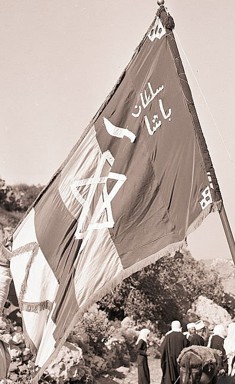 image located by William Garrison
image located by William Garrison
I received a fax from Zvi Ruder with a photo of
Israeli Druze flag, which I never saw before. I scan the photo
which is in poor condition after being processed through fax
machine. The Arabic inscription on the flag is Sultan Basha
(=Pasha) which is the name of a famous Druze leader. [Meanwhile we found a better version of this
photo.]
Dov Gutterman, 13 September 1999
Original caption: "05/02/1949 – Hittin, Israel: Here the Druze flag shows its ancient design,
the Star of David, which the people claim carries over from the days of King Solomon. The Arabic letters,
translated read the name of one of their famous leaders, Sultan Pasha." (source [with uncropped image])
located by William Garrison, 2 November 2024
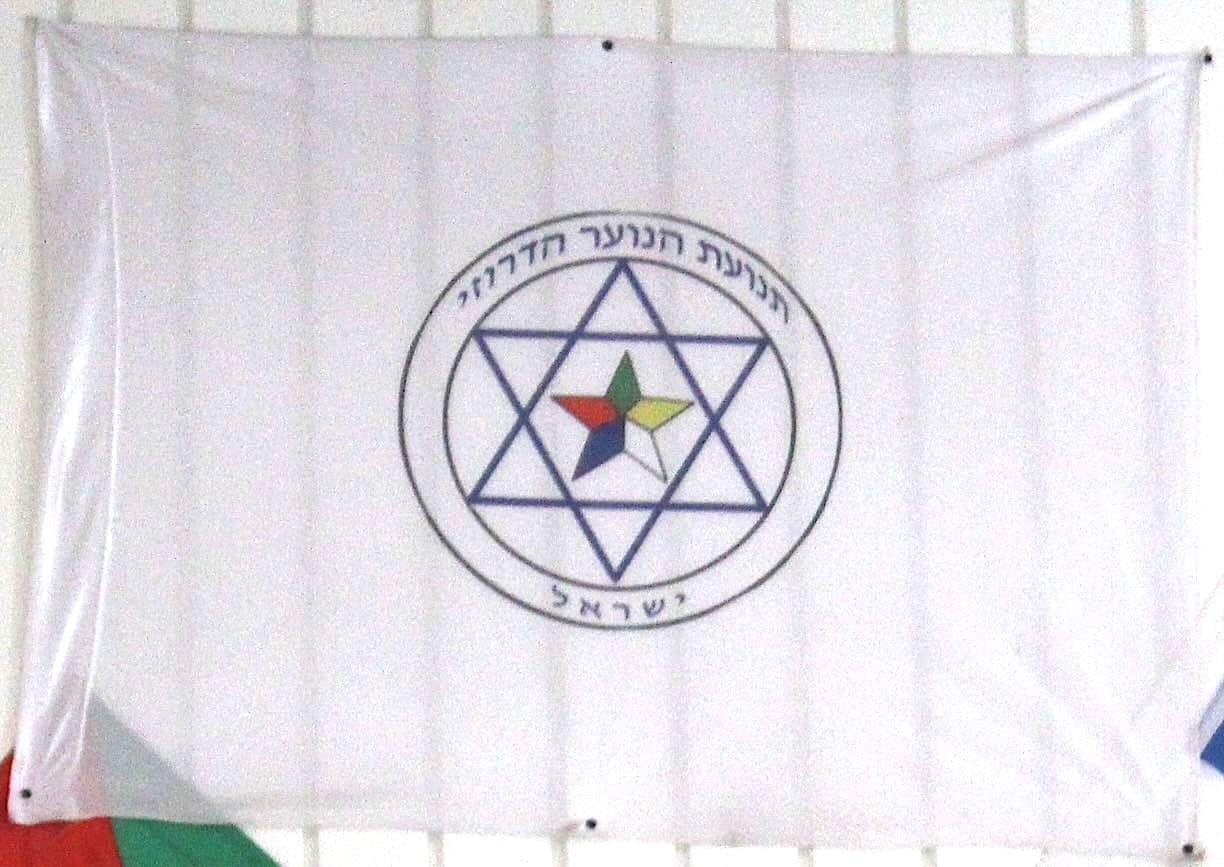 image located by Tomislav Todorovic
image located by Tomislav Todorovic
(picture, source)
Flag of Druze Youth Movement. Inscription above: "Druze Youth Movement"
(Hebrew: תנועת הנוער הדרוזי, tenuat hanoar hadrusi);
below: Israel (ישראל).
located by Tomislav Todorovic, 2 May 2025
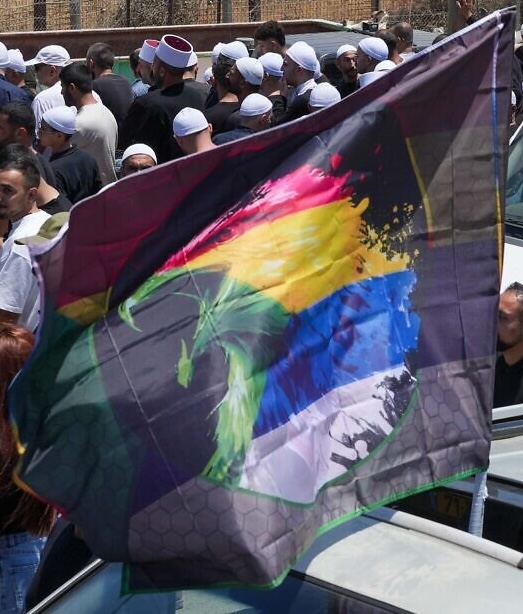 image located by William Garrison
image located by William Garrison
(picture, source)
An unidentified Druze flag seen near Majdal Shams, Israel (northeastern corner of the Golan Heights)
near its border with adjacent Syria; 16 July 2025. The layering of the colorful stripes on this flag match
the order of similar colors in the typical Druze-Israel flag. Maybe it's just my vivid imagination but the
multi-color artwork appears to resemble a defiant "screeching hawk", of which there are several
species in that region.
Caption: "Druze residents protest near the Israeli-Syrian border fence in solidarity with their
community in Syria, in Majdal Shams, July 16, 2025. Photo by Ayal Margolin/Flash90"
William Garrison, 22 July 2025
 image located by Esteban Rivera
image located by Esteban Rivera
(picture, source)
This variant was originally reported back on June 15, 2015, published
online two days later. The picture caption reads: "Syrian and Druze
flags at a pro-Assad protest in the Druze village of Majdal Shams in
the Golan Heights on Monday. (Melanie Lidman/Times of Israel)".
Esteban Rivera, 20 August 2025
The Druze flag is combined from 5 colors which represent the 5 prophets of the Druze secret religion.
This is what a Druze friend told me and I hope he knows what he was talking about ... The Druze religion is
based principally on reincarnation. The exact rules and orders, all the prayers and even books are well
hidden by this community even to its own members and only when they are of a certain age are they allowed
in. It all started a few centuries ago in Iran where they were persecuted by the Muslims. Their temples
back there were burnt and they fled to the Middle East. The Druze people never seek their own country but
are loyal to the country which holds their lands. You can find them in Israel, Lebanon and Syria and they
are said to be the best warriors (since they are not afraid to die). By the way they are not exactly Arabs
(although speaking Arabic), they are of Persian origin.
Shai Tejman, 11 January 1999
I've looked into Concise Encyclopaedia of Arabic Civilization, S. and N. Ronart, Amsterdam, 1966:
"The basis of the Druze creed is the belief in the periodical manifestation of God in a human form (makam, lit. place), comparable to a veil behind which the Divine Nature is hidden. For the last five incarnations were chosen the persons of the Fatimid caliphs al-Qa'im (934–946), al-Mansur (946–952), al-Mu'izz (950–975), al-'Aziz (975–996) and al-Hakim (997–1021), the ultimate and most sublime. From him emanate the Five Principles expressing the Creative Force."Furthermore are mentioned: al-Hakim, Hamzah ibn-'Ali, Moise, Christ and Muhammad, 5 prophets.
At last, I received written material about the Druze and their flag. It seems the verbal information that I received and posted before was misleading and mistaken. The current source is a booklet issued by the Druze in Hebrew so here is a translation of its interesting parts:
The Druze congregation: The origin of the congregation's name is taken from the name of el-Drzi, one of the known propagandists of the Druze religion at its beginning. The religion was called at the beginning al-Tukhid and the Druze were called al-Mukhadun.Dov Gutterman, 9 May 1999The Druze religion was established at the beginning of the 11th century but only in the 19th century were they recognized as an independent congregation by the Ottoman regime.
The Druze are recognized today as independent and separate congregations by the governments of Israel, Lebanon and Syria.
The only Druze flag is combined by a green triangle at the hoist side, and four horizontal stripes of red-yellow-blue-white. The meanings of the colours are:
- Red – symbolizes the heart and love of humanity
- Green – symbolizes the farmer and the life
- White – symbolizes the purity and the air
- Yellow – symbolizes the sun and the wheat
- Blue – symbolizes the sky and the faith
Here is an explanation [for the colour scheme] from the Israel Druze Society website:
Druze religious symbol is a five-coloured flag consisting of Green, Red, Yellow, Blue and White respectively. These colours represent the five wise prophets of Al-Mowahideen.
- Green (Al-Akl) symbolizes "the mind", Christ's Consciousness, the pristine mirror of truth, Plato's sun whose light makes knowledge of the truth possible.
- Red (Al-Nafs) symbolizes "the soul", the moon (the gentle reflector of the sun) the reciever of the light, and the shaheed of the truth in every age.
- Yellow (Al-Kalima) symbolizes "the word", who's the mediator between Plato's realm of eternity and Aristotle's realm of material existence. "The word" after all is the purest form of expression and the softest embodiment of the truth.
- Blue (Al-Sabik) symbolizes the potential, the mental power of the will to become.
- White (Al-Tali) Symbolizes the actualization of the potential, the becoming of the blue power, the full materialization of Plato's world of forms in the world of matter.
Dov Gutterman, 13 September 1999
I was in Israel last week touring the county. While in the Golan Heights area I saw what I understand is
a variant of the Druze flag, with five stripes: from top to bottom, Green, Red, Yellow, Blue and White.
The Druze are according to my encyclopedia:
A member of a Syrian people following a religion marked by monotheism and a belief in al-Hakim (985–1021), an Ismaili caliph, as the embodiment of God.
This flag I found flying in a Druze Village near the Golan Heights. I understand from some Druze that I talked with in an other area that the Druze in Golan area have adopted this flag in an effort to identify more with Syria. Which makes sense as according to my encyclopedia:
Many Druze living in the Golan Heights consider themselves Syrian and refuse Israeli citizenship, while the remainder consider themselves Israeli.
[That was the case as long as the Druze couldn't be sure if the Golan Heights would be given back one day to Syria. They expected to be massacred then
if they would show the same degree of loyalty towards Israel, as the other Druze in Israel do. Now, in 2025, it's the Syrian Druze who would like to
become part of Israel, because they have no other protection against the Islamist regime.]
Wayne Lovett, 19 June 2005
I think that this flag has nothing to do with it, and it is just a regular 5-stripe flag.
I know this same flag which is hoisted in the Druze village of Masa'ade and the top stripe is dark-green,
and not black.
Dov Gutterman, 20 June 2005
![[Druzes (Israel), probably wrong flag]](../images/i/il!druz1.gif) image by António Martins-Tuválkin, 12 April 2018
image by António Martins-Tuválkin, 12 April 2018
In the Flags of Aspirant
Peoples chart appears "28. Druzes – Israel".
Horizontal green-red-yellow-blue-white with a white solid Magen
David shifted to upper fly (centered on red stripe). Since our
experts from Israel report something rather different, I assume this flag is a mistake.
Ivan Sache, 13 September 1999
There is no way it can have a light blue stripe unless
somebody saw a faded flag. It should be dark blue like the image at the top. As I mentioned already, this is
a probably ad-hoc flag, and I never saw one like it.
Dov Gutterman, 14 September 1999
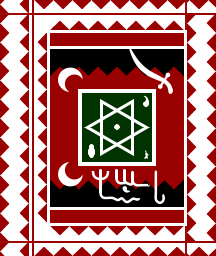 image by Eugene Ipavec, 22 December 2009
image by Eugene Ipavec, 22 December 2009
My brother, Eli Gutterman, sent me a link to a short film that was
taken in Israel in 1951. The film was sponsored by Air France but it is narrated
in English. It is a little over 9 minutes and can be seen at
www.readme.co.il.
Close to its end, there are scenes from a celebration in the
Druze village of Beit Jann in which a
unique flag is seen.
The flag is a combination of Druze symbols (sword, crescents,
the inscription in Arabic "Sultan Basha" [aka Sultan
Pasha al-Atrash – a legendary Druze figure and the
leader of the Druze revolt of 1925]) and the Israeli Magen David.
Dov Gutterman, 22 October 2008
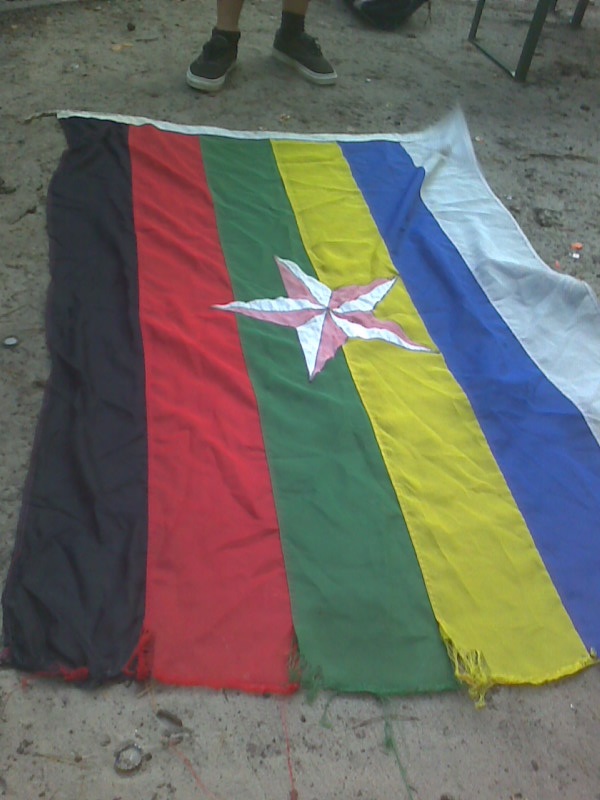
image taken from UFE section 12-55. Possible D-Day Omaha Beach Flag
I believe we should definitely label this flag as a Druze flag.
Certain elements may conclude that, as follows: judging from the time
when it was reported (2012), the way it was portrayed ("in the flesh"
vs. a museum piece) and the condition it portrays (a rather well
preserved instead of a 70+ year old specimen when compared to a
possible SHAFE design) are all indications that it is a rather recent
flag when reported. Additionally, notice even the five-pointed star
featured in the middle which is also a symbol used by the Druze, even
though the star used in recent times by the Druze people has a
different color composition.
As for the black stripe it features, it may well be a reference to the
Syrian flag, something that may then enable us to allocate it to the
Druze People (Syria) page.
I leave this open to discussion.
Esteban Rivera, 21 August 2025
I think this is too strained. The flag was spotted in France and
nothing suggests that it may have been related to Druze people and/or
Syria, except some design similarities, which don't seem sufficient
for a definite conclusion.
Tomislav Todorovic, 21 August 2025